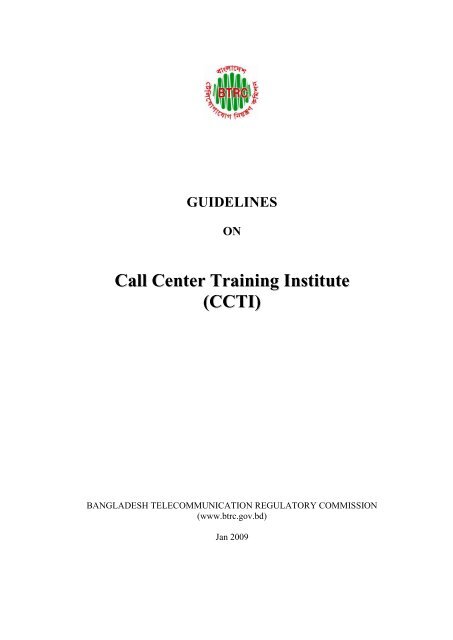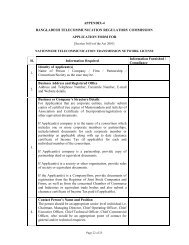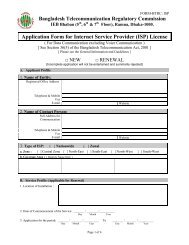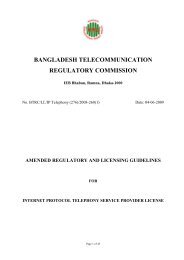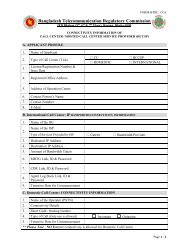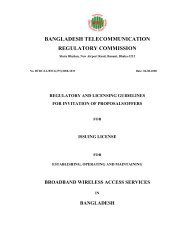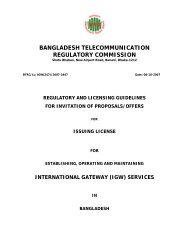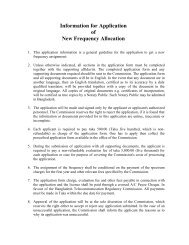Guidelines on Call Centre Training Institute - BTRC
Guidelines on Call Centre Training Institute - BTRC
Guidelines on Call Centre Training Institute - BTRC
You also want an ePaper? Increase the reach of your titles
YUMPU automatically turns print PDFs into web optimized ePapers that Google loves.
GUIDELINES<br />
ON<br />
<strong>Call</strong> Center <strong>Training</strong> <strong>Institute</strong><br />
(CCTI)<br />
BANGLADESH TELECOMMUNICATION REGULATORY COMMISSION<br />
(www.btrc.gov.bd)<br />
Jan 2009
ABBREVIATIONS<br />
1. MoPT Ministry of Posts & Telecommunicati<strong>on</strong><br />
2. <strong>BTRC</strong> Bangladesh Telecommunicati<strong>on</strong> Regulatory Commissi<strong>on</strong><br />
3. CC <strong>Call</strong> Center<br />
4. HCC Hosted <strong>Call</strong> Center<br />
5. HCCSP Hosted <strong>Call</strong> Center Service Provider<br />
6. CCTI <strong>Call</strong> Center <strong>Training</strong> <strong>Institute</strong><br />
7. TIAC <strong>Training</strong> <strong>Institute</strong> Accreditati<strong>on</strong> Committee<br />
2
What is CCTI ?<br />
<strong>Call</strong> Center <strong>Training</strong> <strong>Institute</strong>, where <strong>Call</strong> Center Agent(s) and related pers<strong>on</strong>nel will be<br />
trained to operate as agent/operator for any call center. These institutes will operate<br />
commercially for imparting call center related training.<br />
Who will accredit CCTI ?<br />
The CCTIs should be accredited by <strong>Training</strong> <strong>Institute</strong> Accrediting Committee (TIAC). The<br />
details regarding TIAC is given at Annex – A.<br />
Objectives of this guideline<br />
The goals of this Guideline are:<br />
<br />
<br />
<br />
<br />
To promote the accreditati<strong>on</strong> for the <strong>Call</strong> Center <strong>Training</strong> <strong>Institute</strong>s<br />
To put a framework for the training courses, faculty, and others.<br />
To m<strong>on</strong>itor the infrastructure and technical availabilities of the CCTIs<br />
To ensure the quality of the training provided by the CCTIs<br />
3
<str<strong>on</strong>g>Guidelines</str<strong>on</strong>g> for <strong>Call</strong> Center <strong>Training</strong> <strong>Institute</strong> (CCTI)<br />
Secti<strong>on</strong> : 1<br />
General C<strong>on</strong>diti<strong>on</strong>s:<br />
1. All CCTI must follow the guidelines menti<strong>on</strong>ed in this document to get accreditati<strong>on</strong><br />
from the <strong>Training</strong> <strong>Institute</strong> Accreditati<strong>on</strong> Committee.<br />
2. It has been decided to extend support to the <strong>Call</strong> Center Trainees and Licensees to<br />
get better trained operators/agents from the local market. Following are broad<br />
guidelines for establishment and operati<strong>on</strong>s of CCTI in Bangladesh:<br />
i. Accreditati<strong>on</strong> is mandatory for all CCTIs by the committee under MoPT<br />
(Menti<strong>on</strong>ed Annexure-A).<br />
ii.<br />
iii.<br />
iv.<br />
There will be an accreditati<strong>on</strong> m<strong>on</strong>ogram (Menti<strong>on</strong>ed Annexure-B).<br />
All accredited CCTIs will be allowed/encouraged to use the m<strong>on</strong>ogram <strong>on</strong> all<br />
stati<strong>on</strong>eries, advertisements and displays. However, the use of this m<strong>on</strong>ogram<br />
bey<strong>on</strong>d accreditati<strong>on</strong> validity period will be strictly prohibited.<br />
Accreditati<strong>on</strong> fee and Renewal fee is NOT APPLICABLE.<br />
v. CCTI, at minimum, needs to follow the Curriculum that they have submitted which<br />
must meet the minimum curriculum as menti<strong>on</strong>ed Annexure – C.<br />
vi.<br />
vii.<br />
viii.<br />
ix.<br />
All CCTI must have their own website and must publish updated curriculum in the<br />
website<br />
The trainer(s) must be graduate or have experiences at least 3 years in relevant<br />
subject/field<br />
TIAC will visit any CCTI at any time to verify and if any inc<strong>on</strong>sistency found<br />
disciplinary acti<strong>on</strong> will be taken by the authority.<br />
A CCTI will have to apply for accreditati<strong>on</strong> and the TIAC will certify or reject<br />
their applicati<strong>on</strong>s within 30 working days from the date of submissi<strong>on</strong>.<br />
x. In case of any grievance or complain from the trainees/students, the Accreditati<strong>on</strong><br />
committee will have the authority take appropriate acti<strong>on</strong>.<br />
xi.<br />
xii.<br />
xiii.<br />
The CC/HCC/HCCSP Licensee shall not require any such Accreditati<strong>on</strong> for their<br />
own in-house training. But they cannot commercially act as CCTI.<br />
<strong>BTRC</strong> can change or modify this guideline at anytime.<br />
TIAC will meet <strong>on</strong>ce a m<strong>on</strong>th or as and when required.<br />
4
Annexure - A<br />
Visi<strong>on</strong><br />
<strong>Training</strong> <strong>Institute</strong> Accreditati<strong>on</strong> Committee (TIAC)<br />
It will facilitate growth of <strong>Call</strong> <strong>Centre</strong> <strong>Training</strong> <strong>Institute</strong>s (CCTIs) in Bangladesh and, in<br />
turn, <strong>Call</strong> <strong>Centre</strong> industry by ensuring quality in every aspects of training of agents.<br />
Objectives<br />
The committee will have the following objectives:<br />
1. ensure that CCTIs deliver promise what they have promised and no trainees are<br />
deceived/cheated<br />
2. ensure internati<strong>on</strong>ally acceptable quality training by means of well trained faculty,<br />
excellent learning envir<strong>on</strong>ment, up to date curriculum<br />
3. facilitate the growth of call centre industry by maintaining a str<strong>on</strong>g relati<strong>on</strong>ship<br />
between the industry and the CCTIs<br />
4. time to time assess the changes in the envir<strong>on</strong>ment and ensure immediate upgradati<strong>on</strong><br />
of CCTIs curriculum<br />
TIAC should work to ensure that the following threats are eliminated/minimized in the<br />
CCTI industry:<br />
1. Trainees/students are being cheated with false promises<br />
2. <strong>Training</strong>s are too expensive for the students<br />
3. low quality trainings (in terms of faculty, infrastructure, curriculum) are being<br />
imparted<br />
By minimizing the threats TIAC will maximize the opportunities of CCTIs by ensuring<br />
that<br />
1. All required comp<strong>on</strong>ents needed for working as a call centre agent are taught<br />
2. Bangladeshi agents are globally competitive and qualified<br />
3. There are many excellent CCTIs all over the country<br />
4. Operati<strong>on</strong>s of all CCTIs is transparent and they are accountable to TIAC<br />
5. Overall, the CCTIs should work as a cohesive up stream comp<strong>on</strong>ent of call centre<br />
industry value chain<br />
The organizati<strong>on</strong> of TIAC<br />
TIAC will have the following structure<br />
MoPT<br />
<strong>BTRC</strong> BCC BCS BACCO<br />
BASIS<br />
5
How TIAC should work<br />
1. TIAC should set their own scope of work and detailed specificati<strong>on</strong>s for evaluating<br />
different CCTIs.<br />
2. TIAC should take measures to supervise the operati<strong>on</strong>al activities and performance<br />
of a CCTI even after the respective approval of the training operati<strong>on</strong>.<br />
3. The body should m<strong>on</strong>itor the real existence and c<strong>on</strong>tinuati<strong>on</strong> of the proposed<br />
criteria and facilities by rotati<strong>on</strong>al physical visits.<br />
4. Initially <strong>BTRC</strong> will provide logistic and other supports and finally it should be a<br />
self sustaining body.<br />
5. They Board can outsource the services to be delivered or they will provide it <strong>on</strong><br />
their own.<br />
6. Accreditati<strong>on</strong> of CCTIs should not be mandatory rather it should be encouraged.<br />
7. The accreditati<strong>on</strong> committee may have a small administrative/support team at the<br />
beginning<br />
8. All CCTIs will be encouraged to be assessed/evaluated by TIAC<br />
9. Example of services that will be provided by TIAC could be:<br />
a. Issue of certificates of different categories:<br />
a. Accreditati<strong>on</strong> is time bound and it should be imprinted <strong>on</strong> the m<strong>on</strong>ogram so<br />
that citizens can understand when the last certificate was received by a<br />
specific CCTI<br />
b. Time-to-time arrange awareness programmes for potential trainees<br />
c. Informati<strong>on</strong> services to the CCTIs<br />
10. TIAC will time to time study the industry and educate its members/subscribers <strong>on</strong><br />
different aspects of the business<br />
11. TIAC will randomly assess different CCTIs for compliance themselves<br />
12. Trainees will be encouraged to get admissi<strong>on</strong> at TIAC certified CCTIs and at the<br />
same time TIAC will have to ensure that the best agents are coming out from its<br />
own pull of CCTIs<br />
6
13. TIAC should c<strong>on</strong>firm the following criteria of training method are present in the<br />
CCTI all the time<br />
a. Effective less<strong>on</strong> plan, deliberate curriculum and the faculty guide<br />
b. Faculty evaluati<strong>on</strong> process and need-based modificati<strong>on</strong> of faculties<br />
c. Course lineup and schedule with effective c<strong>on</strong>tent and time management<br />
d. Adequate opportunities for Practical training<br />
e. Effective exam practice and evaluati<strong>on</strong> of the trainees<br />
14. The regulatory entity should ensure the following criteria of the infrastructural<br />
facilities of a CCTI are present.<br />
a. Seat arrangement and well-furnished classroom envir<strong>on</strong>ment for all the<br />
trainees. There must be a minimum 20 (twenty) seat infrastructure for a<br />
CCTI. There should be sufficient space for training and facilities.<br />
b. Adequate teleph<strong>on</strong>ic devices, computers, hardware etc. for training for each<br />
seat<br />
c. Proper electricity supply and back-up power support for uninterrupted<br />
training program<br />
d. Appropriate architecture for the network with uninterrupted c<strong>on</strong>nectivity<br />
equipped with physical redundancy and adequate ports<br />
e. Facilities for inbound voice soluti<strong>on</strong> and other teleph<strong>on</strong>ic supports<br />
f. Audio-visual gadgets, proper sound system, projecti<strong>on</strong> facilities etc.<br />
g. Adequate training resources i.e. books, journals, handouts, learning CD etc.<br />
h. Fire protecti<strong>on</strong>, ventilati<strong>on</strong> and healthy aerati<strong>on</strong><br />
15. TIAC should screen the following quality of a trainer/faculty in a <strong>Call</strong> Center<br />
Service training center<br />
a. Relevant academic excellence and experience of respective training faculty<br />
should be there. A minimum of 3 trainers must be engaged <strong>on</strong> full time<br />
basis<br />
b. Communicative skill and interactivity with the trainees:<br />
7
c. Encouraging and impressive mode of speech delivery<br />
d. Str<strong>on</strong>g command <strong>on</strong> linguistic accent and capability to c<strong>on</strong>vey clear<br />
differentiati<strong>on</strong> am<strong>on</strong>g several regi<strong>on</strong>al accents and dialects.<br />
e. Ability to handle objecti<strong>on</strong>s and queries with patience and competence<br />
f. Having impressive facial expressi<strong>on</strong> and eye c<strong>on</strong>tact with the audience<br />
g. Familiarity with call center equipment and tele-communicati<strong>on</strong><br />
h. Good record of punctuality and time management<br />
8
Annexure - B<br />
M<strong>on</strong>ogram :<br />
This m<strong>on</strong>ogram can use <strong>on</strong>ly the certified CCTI.<br />
9
Annexure - C<br />
<strong>Training</strong> Curriculum:<br />
Table of c<strong>on</strong>tent<br />
1 Overview ................................................................................................................ 11<br />
2 Introducti<strong>on</strong> to <strong>Call</strong> Center Industry and the Professi<strong>on</strong> ........................................ 11<br />
3 Language Proficiency............................................................................................. 11<br />
3.1 Effective Listening ............................................................................................. 11<br />
3.1.1 Objectives .................................................................................................... 11<br />
3.1.2 Descripti<strong>on</strong> .................................................................................................. 11<br />
3.1.3 What topics should be covered? .................................................................. 11<br />
3.2 C<strong>on</strong>versati<strong>on</strong> Skill .............................................................................................. 12<br />
3.2.1 Objectives .................................................................................................... 12<br />
3.2.2 Descripti<strong>on</strong> .................................................................................................. 12<br />
3.2.3 What topics should be covered? .................................................................. 12<br />
4 Language Skill ....................................................................................................... 12<br />
4.1 Objectives ........................................................................................................... 12<br />
4.2 Descripti<strong>on</strong> ......................................................................................................... 13<br />
4.3 What topics should be covered? ......................................................................... 13<br />
5 Computer - Teleph<strong>on</strong>e Interacti<strong>on</strong> ......................................................................... 13<br />
5.1 Computer Basics ................................................................................................. 13<br />
5.2 Teleph<strong>on</strong>e Basics ................................................................................................ 13<br />
6 An elaborati<strong>on</strong> of the guideline <strong>Call</strong> Center <strong>Training</strong> Facilities ............................ 14<br />
6.1 C<strong>on</strong>tent of the training programme .................................................................... 14<br />
6.2 Evaluate the performance ................................................................................... 14<br />
6.3 Tools to identify and meet customer needs ........................................................ 15<br />
6.4 Ph<strong>on</strong>e etiquette ................................................................................................... 15<br />
6.5 A Dummy <strong>Training</strong> Program for Teleph<strong>on</strong>e Skills ............................................ 16<br />
10
Overview<br />
In the <strong>Call</strong> Center training students should learn about the fundamentals of call center<br />
operati<strong>on</strong>s, including an overview of the industry, performance measurement and<br />
management, workforce planning, effective interviewing and hiring, and call center<br />
technology. The class should also provide a proven step-by-step approach to coaching for<br />
improved performance, including how to measure and record performance, c<strong>on</strong>duct a<br />
performance "gap analysis", diagnose problems and develop an improvement plan, and apply<br />
the steps of positive discipline when performance does not improve. Courses facility should<br />
also include developing motivati<strong>on</strong>al programs to encourage <strong>on</strong>going performance excellence<br />
and employee retenti<strong>on</strong>.<br />
Introducti<strong>on</strong> to <strong>Call</strong> Center Industry and the Professi<strong>on</strong><br />
<strong>Call</strong> Center trainees should get an overview of the call center industry with a look at the<br />
demographics as well as the types and functi<strong>on</strong>s of call centers. They should also understand<br />
the roles and resp<strong>on</strong>sibilities in a call center and the benefits of the call center professi<strong>on</strong>.<br />
Followings should be covered in general in training sessi<strong>on</strong>.<br />
> Examine the demographics associated with today's call center industry.<br />
> Define the various types and functi<strong>on</strong>s of call centers.<br />
> Outline the various roles the call center may play in the organizati<strong>on</strong>.<br />
> Define the typical roles in a call center and the resp<strong>on</strong>sibilities of each.<br />
> Describe the call center professi<strong>on</strong> and its benefits.<br />
Language Proficiency<br />
Effective Listening<br />
Objectives<br />
Applying effective listening skills over the teleph<strong>on</strong>e presents unique challenges to the<br />
c<strong>on</strong>tact centre agent, when compared to face-to-face communicati<strong>on</strong>s. Yet good listening is<br />
the criTIACl first step in any customer c<strong>on</strong>tact and is the key to understanding your<br />
customers' needs and to building and strengthening customer relati<strong>on</strong>ships<br />
Descripti<strong>on</strong><br />
Listening can be <strong>on</strong>e of the most demanding aspects of c<strong>on</strong>tact centre communicati<strong>on</strong> and,<br />
when d<strong>on</strong>e well, <strong>on</strong>e of the most rewarding. The Effective Listening Skills workshop should<br />
give your agents the skills they need to determine their customers' needs, gather important<br />
informati<strong>on</strong> and avoid misunderstanding and frustrati<strong>on</strong>, resulting in positive customer<br />
percepti<strong>on</strong> and increased customer loyalty.<br />
What topics should be covered?<br />
> Assessing listening style and identifying areas for improvement<br />
> Avoiding the most comm<strong>on</strong> faults of poor listeners and the accompanying<br />
prescripti<strong>on</strong>s to better listening<br />
> Applying and practicing empathetic listening
Listening "n<strong>on</strong>-visually" and "n<strong>on</strong>-verbally"<br />
> Taking notes and processing informati<strong>on</strong> effectively<br />
> Accent Development<br />
> Practical training<br />
C<strong>on</strong>versati<strong>on</strong> Skill<br />
Objectives<br />
Like listening, c<strong>on</strong>versati<strong>on</strong> skill also posses challenge for call center agents, when<br />
compared to face to face communicati<strong>on</strong>. Yet good c<strong>on</strong>versati<strong>on</strong> skill is another pre-requisite<br />
to effective communicati<strong>on</strong> for building customer relati<strong>on</strong>ship.<br />
Descripti<strong>on</strong><br />
C<strong>on</strong>versati<strong>on</strong> with the customer is <strong>on</strong>e of most the demanding aspects of c<strong>on</strong>tract center.<br />
When d<strong>on</strong>e well, it is most rewarding. The effective c<strong>on</strong>versati<strong>on</strong> skill should give agents the<br />
skill they need to satisfy customer query, clear misunderstanding and frustrati<strong>on</strong> resulting in<br />
positive percepti<strong>on</strong>.<br />
What topics should be covered?<br />
> Assessing c<strong>on</strong>versati<strong>on</strong> style and identifying areas of improvement<br />
> Avoid miss-communicati<strong>on</strong> by proper c<strong>on</strong>versati<strong>on</strong><br />
> Inter-pers<strong>on</strong>al communicati<strong>on</strong> skill<br />
> Understanding skill for effective c<strong>on</strong>versati<strong>on</strong><br />
> Ability to understand and resp<strong>on</strong>d as per demand<br />
> Familiar with call center equipment and tele-communicati<strong>on</strong><br />
> Taking notes and processing informati<strong>on</strong> effectively<br />
> Cross culture training<br />
> Practical training<br />
> Interview practices<br />
Language Skill<br />
Objectives<br />
Like listening & c<strong>on</strong>versati<strong>on</strong> skill language skill also posses an unique challenge for call<br />
center agents, when compared to face to face communicati<strong>on</strong>. Yet good language skill is also<br />
12 of 19
another pre-requisite to effective communicati<strong>on</strong> for building and strengthening customer<br />
relati<strong>on</strong>ship.<br />
Descripti<strong>on</strong><br />
Language skill with the customer is <strong>on</strong>e of most the demanding aspects of c<strong>on</strong>tract center.<br />
When understood well, it becomes much easier for the agent to communicate most effectively.<br />
D<strong>on</strong>e well, it is most rewarding. The effective language skill should give agents the skill they<br />
need to satisfy customer query, make them comfort resulting in positive percepti<strong>on</strong> and<br />
building customer relati<strong>on</strong>ship.<br />
What topics should be covered?<br />
> Understanding language and resp<strong>on</strong>ding accordingly<br />
> Avoid miss-communicati<strong>on</strong> by poor understanding of language<br />
> Fluency in language<br />
> Understanding different accent<br />
> Perfect sentence c<strong>on</strong>structi<strong>on</strong><br />
> Good writing skill<br />
> Understanding customer resp<strong>on</strong>se<br />
> Customer Services Skills<br />
> Practical <strong>Training</strong><br />
Computer - Teleph<strong>on</strong>e Interacti<strong>on</strong><br />
Computer Basics<br />
> Basic computer operati<strong>on</strong>s (Introducti<strong>on</strong> to PC)<br />
> Applicati<strong>on</strong>s and operating systems fundamentals<br />
> Appropriate typing methods and skills (Need to skill them in typing)<br />
> How to interact with different applicati<strong>on</strong>s related to management of call management.<br />
The centre will have to impart practical training the agent in call centre software.<br />
Teleph<strong>on</strong>e Basics<br />
> Different types of teleph<strong>on</strong>e used for computer aided customer services<br />
> Standard dialing procedures using different types of ph<strong>on</strong>es<br />
13 of 19
Receiving <strong>Call</strong>s<br />
> <strong>Call</strong> forwarding<br />
> <strong>Call</strong> Transfer and c<strong>on</strong>ferencing<br />
> On-Hold Techniques: Learn a right way to put a caller <strong>on</strong> hold.<br />
> <strong>Call</strong>-Transferring: Learn the guided transfer and the descripti<strong>on</strong> transfer.<br />
An elaborati<strong>on</strong> of the guideline <strong>Call</strong> Center <strong>Training</strong> Facilities<br />
C<strong>on</strong>tent of the training programme<br />
1. Voice t<strong>on</strong>e techniques that quickly build a healthy understanding with customers<br />
2. Effective methods to guide and c<strong>on</strong>trol a ph<strong>on</strong>e call<br />
3. Techniques to create a positive first and lasting impressi<strong>on</strong><br />
4. Delivering a negative message in a positive way while increasing acceptance and<br />
understanding<br />
5. How their frame of mind can help or hinder customer service excellence<br />
6. Ways to satisfy a customer’s emoti<strong>on</strong>al needs<br />
7. How to transform an unhappy customer into a satisfied <strong>on</strong>e without supervisor<br />
interventi<strong>on</strong><br />
8. How to view teleph<strong>on</strong>e work as meaningful and rewarding<br />
9. Determine a customer’s needs and the best way to meet those needs<br />
10. Choose the right words to communicate the sales message<br />
11. Overcome fears of selling<br />
12. Ask for a decisi<strong>on</strong> to get better results<br />
13. Meet and melt buyer resistance for taking acti<strong>on</strong> – a new approach to overcoming<br />
objecti<strong>on</strong>s<br />
14. Open the call in a way that sets the stage for positive interacti<strong>on</strong>s<br />
15. Use voice t<strong>on</strong>e to build str<strong>on</strong>g rapport<br />
16. Approach the sale from the buyer's perspective<br />
17. Develop current accounts to increase sales activity<br />
14 of 19
Evaluate the performance<br />
1. Define Positive and Negative Stress<br />
2. Take a test to determine each participant's current stress level<br />
3. Discover the importance of proper breathing to reduce stress<br />
4. Participate in several individual and group stress reducti<strong>on</strong> activities<br />
5. Examine "the power of choice" and the effect your choices have<br />
6. Learn "at-your-desk" techniques to practice during stressful situati<strong>on</strong>s<br />
Tools to identify and meet customer needs<br />
1. Better time management for each call<br />
2. Methods to appropriately appeal to customer interest<br />
3. Improved self-satisfacti<strong>on</strong> by being a better communicator<br />
4. Increased unity within a team dynamic<br />
5. Recognize important communicati<strong>on</strong> signals more clearly<br />
Ph<strong>on</strong>e etiquette<br />
Preparati<strong>on</strong>: Take certain preparati<strong>on</strong> steps to listen better and c<strong>on</strong>centrate.<br />
A Str<strong>on</strong>g Start: Learn to impress any caller by greeting.<br />
Building Rapport: Learn proven techniques to build rapport with a caller.<br />
Effective On-Hold Techniques: Learn a right way to put a caller <strong>on</strong> hold.<br />
Effective <strong>Call</strong>-Transferring: Learn the guided transfer and the descripti<strong>on</strong> transfer.<br />
Speaking Clearly: Should be able to enunciate and speak clearly.<br />
Proper T<strong>on</strong>e of Voice: Learn to treat each ph<strong>on</strong>e call as a separate performance.<br />
Positive Speech: There are certain words and phrases that can quickly turn off a caller;<br />
c<strong>on</strong>versely, there are words and phrases that are music to a caller’s ears.<br />
Effective Listening: Learn the right techniques for diffusing an angry caller.<br />
Practice the Golden Rule: Should treat the caller with the same dignity and respect you<br />
extend to the owner of your company.<br />
15 of 19
A Dummy <strong>Training</strong> Program for Teleph<strong>on</strong>e Skills<br />
<br />
<br />
<br />
<br />
<br />
<br />
<br />
<br />
<br />
A fully customized ph<strong>on</strong>e training program designed to address your unique needs<br />
and challenges<br />
A report of what was learned from teleph<strong>on</strong>e customer service audits<br />
The Ph<strong>on</strong>e Coach's "best practices" for achieving teleph<strong>on</strong>e customer service<br />
excellence<br />
The different communicati<strong>on</strong> styles and how to identify them through speech, t<strong>on</strong>e,<br />
and pace<br />
How to adopt or "flex" your communicati<strong>on</strong> style to match/mirror that of the caller<br />
How to handle difficult and problem calls<br />
Sample random business' teleph<strong>on</strong>e customer service experience via speakerph<strong>on</strong>e<br />
Discussi<strong>on</strong> and interacti<strong>on</strong><br />
Humor<br />
16 of 19
Annexure - E<br />
Infrastructure & Facilities :<br />
<br />
<br />
every institute must have an individual setup in any commercial premises with<br />
maintain the standard of a training institute.<br />
CCTI must have Lecture Room and Practical lab with the followings;<br />
a) Computer with internet and LAN c<strong>on</strong>nectivity<br />
b) Head Sets<br />
c) Software (IVR or Predictive Dialer) or any customized S/w for training<br />
17 of 19
Secti<strong>on</strong> : 2<br />
Bangladesh Telecommunicati<strong>on</strong> Regulatory Commissi<strong>on</strong><br />
5 th ,6 th & 7 th Floor, IEB Bhaban, Ramna, Dhaka-1000.<br />
A. APPLICANT PROFILE<br />
APPLICATION FOR<br />
ACCREDITATION OF CCTI<br />
1. Name of Applicant/<br />
Representative of CCTI.<br />
2. Detail Address of<br />
Applicant/Representative of the<br />
CCTI including Ph<strong>on</strong>e, mail,<br />
FAX number and C<strong>on</strong>tact<br />
pers<strong>on</strong>.<br />
Separate sheet may used<br />
3. List of Syllabus or Course<br />
Curriculum<br />
Separate sheet may used<br />
4. List of Trainers with their full<br />
CV and Photos<br />
5. Detail Organogram of the<br />
CCTI<br />
6. Technical specificati<strong>on</strong> of<br />
each equipment and details<br />
infrastructure and facilities.<br />
7. List of equipments and<br />
Employees with full details and<br />
photos.<br />
Separate sheet may used<br />
Separate sheet may used<br />
Separate sheet may used<br />
Separate sheet may used<br />
B. DECLARATION<br />
1. Has any Applicati<strong>on</strong> for Accreditati<strong>on</strong> of CCTI been rejected before? □ Yes □ No<br />
(if yes, please give date of applicati<strong>on</strong> and reas<strong>on</strong>s for rejecti<strong>on</strong>)<br />
2. Has any License issued previously to the Applicant/any Share Holder/Partner been<br />
cancelled?<br />
□ Yes □ No<br />
(if yes, please give details)<br />
18 of 19
3. Do the Applicant/any Share Holder/Partner hold any other Operator Licenses from the<br />
Commissi<strong>on</strong>?<br />
□ Yes □ No<br />
(if yes, please give details)<br />
4. I/We hereby certify that I/We have carefully read the guidelines/terms and c<strong>on</strong>diti<strong>on</strong>s,<br />
for the Accreditati<strong>on</strong> and I/We undertake to comply with the terms and c<strong>on</strong>diti<strong>on</strong>s<br />
therein. (Terms and C<strong>on</strong>diti<strong>on</strong>s of Accreditati<strong>on</strong> <str<strong>on</strong>g>Guidelines</str<strong>on</strong>g> for CCTI is available at<br />
www.btrc.gov.bd.<br />
5. I/We understand that this applicati<strong>on</strong> if found incomplete in any respect and /or if<br />
found with c<strong>on</strong>diti<strong>on</strong>al compliance shall be summarily rejected.<br />
6. I/We understand that if at any time any informati<strong>on</strong> furnished for obtaining the<br />
Accreditati<strong>on</strong> is found incorrect then the license if granted <strong>on</strong> the basis of such<br />
applicati<strong>on</strong> shall deemed to be cancelled and shall be liable for acti<strong>on</strong> as per<br />
Bangladesh Telecommunicati<strong>on</strong> Act, 2001.<br />
Date:<br />
Place:<br />
Signature and name of the<br />
Applicant/Authorized<br />
Signatory with seal<br />
Note: The completed applicati<strong>on</strong> form is to be submitted to:<br />
Director,<br />
Legal and Licensing,<br />
Bangladesh Telecommunicati<strong>on</strong> Regulatory Commissi<strong>on</strong> (<strong>BTRC</strong>)<br />
5 th , 6th & 7 th Floor, IEB Bhaban, Ramna, Dhaka-1000.<br />
19 of 19


